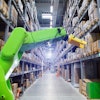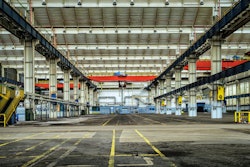
Demand for cold storage warehousing isn’t a new phenomenon, but what is new is the mushrooming call for very specific, complex refrigerated spaces to meet the needs of increasingly sophisticated consumers.
The proper handling and storage of certain types of produce, for example, has grown into big business as part of the collective effort to capitalize on the farm-to-table movement.
Keeping up with booming online and on-trend grocery sales means food companies may consider building a Greenfield distribution facility, and if there isn’t the option or desire for new construction, establishing an expansion space or creating more cold storage space within an existing facility.
Globally, cold storage capacity reached 616 million cubic meters in 2018, an increase of 2.67% since 2016, according to the 2018 GCCA Global Cold Storage Capacity Report, produced by the Global Cold Chain Alliance, Alexandria, Va. The total capacity of refrigerated warehouses in the United States was 131 million cubic meters in 2018, behind only India (150 million cubic meters.)
“The growth of online grocery sales has stoked demand for additional cold storage warehousing space in the U.S., but cost and complexity of constructing cold storage facilities might make meeting that demand challenging,” as outlined in a cold storage warehousing report presented by CBRE, Los Angeles. The “anticipated rise in cold storage construction will spur subtle changes in how and where these facilities are built.”
Product diversity continues to change and evolve
For many large grocery retailers, there are distinct product groups that have grown tremendously on the perishable side. That’s because consumer desire for more fresh, healthy and ready-to-eat items continue to drive production of all-natural, vegan and gluten-free products.
To stay on trend, cold storage facility owners and operators must first dedicate the necessary square footage to multiple temperature zones; determine which products need to be in a temperature-controlled environment and then what the best strategy for doing that is.
Geography may also be a factor within the same company with the same product lineup. For example, an Atlanta confectionery distribution center may need to store chocolate in a conditioned zone and separate from bubble gum, whereas in Minnesota, both items could be stored in a dry, ambient warehouse.
Many fruits and vegetables, such as bananas and mangoes, require multiple dedicated temperature zones with humidity flexibility to ensure that the product arrives at the stores in peak condition.
Take for example a California-based avocado company’s East Coast distribution center, which features rooms ranging from 40-70°F, specially designed for each stage of the ripening process.
Ultimately, cold storage spaces should be conceived to meet owner needs regarding operations and facility locations throughout the country.
Rising land costs drive requests for taller buildings
During the last decade, the industry has seen a tremendous increase in requests for higher clear heights. Clients routinely ask, “How tall can we go?” Cubic volume becomes more important than square footage.
But, there are thresholds and issues to consider such as how to handle fire protection, the type of floor slabs and building accessibility. It takes planning and research to establish optimal height, and once that is determined, many companies decide to incorporate an automated storage and retrieval system (AS/RS). The No. 1 benefit of AS/RS is improved floor space utilization.
Take the baking operation at a global food processor and distributor’s New England facility, for example. After the goods are baked, cooled and palletized, they are put on a conveyor and transferred to the fully racked, unmanned freezer with 150-foot ceilings. There are no human beings in the dark freezer, only the AS/RS system, which quickly and accurately places and retrieves the product for truck deliveries to fast food restaurants in the region.
Advancements in refrigeration technology
Refrigeration capabilities can make or break a company that’s in the business of preserving product integrity. There is no longer a this-is-how-we’ve-always-done-it mentality. Clients want to get it right and rely on reputable design-builders to assess the role that environment, jurisdiction, space, safety and product type plays in the decision about what type of refrigeration system to install.
Companies must also consider efficiency, amount of refrigerant charge, refrigerant type and maintenance accessibility.
Though liquid recirculation systems have been historically used for industrial refrigeration, a host of new systems are being developed and implemented, including direct expansion and Cascade and low-charged packaged units.
For example, a Cascade configuration, or two-stage refrigeration system, handles large temperature gaps by using two different types of energy-efficient refrigerants, thereby taking advantage of each of the refrigerant’s properties and only using them in areas where they best apply. This approach is commonly used for extreme deep freezer conditions, but can also be applied at higher operating temperatures to reduce risk of product loss due to a refrigerant leak. Ammonia could be used as the main refrigerant contained in the machine room and glycol, as the secondary refrigerant, would then be distributed to the evaporators throughout the facility. This setup minimizes the risk of distributing large charges of ammonia, which could contaminate produce, such as acai or other berries.
Each of these refrigeration systems can benefit from the use of prefabrication. Something as simple as the valve groups for refrigeration piping systems can be prefabricated for use in a cold storage distribution facility. However, prefabrication is most often optimized in conjunction with low-charged packaged units, where compressors, controls and evaporators are constructed in a penthouse unit in an off-site location parallel with facility construction. The units are then delivered to the job site and set in place, significantly reducing the amount of on-site labor, cutting overall project timelines and decreasing safety risks.
Finally, the investment in control systems maximizes refrigeration system energy efficiency, prolongs lifespan of equipment, tracks trends and productivity and gives real-time performance.
The future of cold storage
Designing and building a state-of-the-art food distribution facility is challenging. Expanding cold storage space at an existing facility is even more so.
As a rule of thumb, companies are using current assets before investing in new ones. They may be motivated by trying to get products to market more quickly, meeting regulations or answering the challenge of workforce shortages. That’s why we’re seeing a proliferation of expansions and renovations of distribution centers in the food industry.
Each new project will profit from cutting-edge technology such as new systems or hybrids of those systems. There will also be continued focus on automation, diversification of temperature-controlled products and demand for more data and analytics.





















